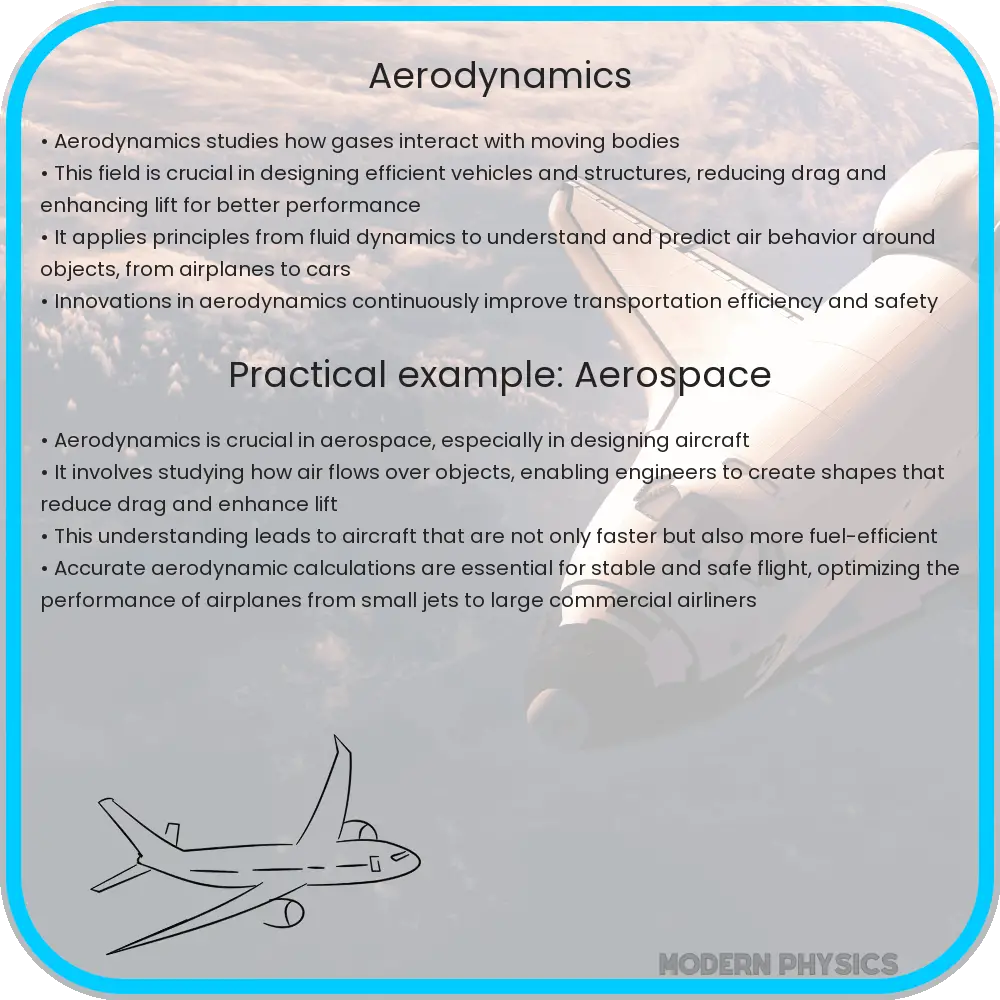Explore the essentials of aerodynamics, from basic principles to advanced applications in aviation, sports, and renewable energy optimization.

Understanding Aerodynamics: Principles and Optimization
Aerodynamics, a branch of fluid dynamics, is crucial in understanding the behavior of air and other gases in motion. It plays a significant role in various fields such as aviation, automotive design, and environmental engineering. This article delves into the fundamental principles of aerodynamics, explores optimization techniques, and examines the complexities of fluid dynamics.
Basic Principles of Aerodynamics
At the core of aerodynamics are the principles of lift, drag, and airflow. Lift is the force that enables an object, like an airplane, to rise against gravity. It is generated by differences in air pressure above and below the wings. Drag, on the other hand, is the resistance an object faces as it moves through a fluid, such as air or water. Airflow refers to the movement of air around solid objects and is categorized into laminar and turbulent flow. Laminar flow is smooth and orderly, while turbulent flow is chaotic and irregular.
Optimization in Aerodynamics
Optimization in aerodynamics is aimed at maximizing efficiency while minimizing energy loss. This involves enhancing the shape and design of objects to reduce drag and increase lift. Computational Fluid Dynamics (CFD) is a key tool used in this optimization process. CFD involves the use of algorithms and numerical analysis to simulate and analyze fluid flows, enabling engineers to predict and optimize aerodynamic performance.
Fluid Dynamics and Its Complexity
Fluid dynamics is a broader field that encompasses the study of liquids and gases in motion. It involves understanding complex equations like the Navier-Stokes equations, which describe the motion of viscous fluid substances. These equations are fundamental in predicting weather patterns, designing aircraft, and even in medical research for blood flow analysis.
The study of aerodynamics is not only about understanding air movement but also involves thermodynamics, as temperature changes significantly affect air density and pressure. The Bernoulli’s principle, which states that an increase in the speed of a fluid occurs simultaneously with a decrease in pressure, is a cornerstone in understanding aerodynamic lift.
Another crucial aspect is the Mach number, which is used to categorize airflow: subsonic (Mach number < 1), transonic (Mach number ≈ 1), supersonic (Mach number > 1 but < 5), and hypersonic (Mach number > 5). Each of these categories has unique characteristics and challenges, particularly in terms of shock waves and boundary layers.
Understanding the complexities of aerodynamics and fluid dynamics is essential in optimizing designs for efficiency and performance. Whether it’s an aircraft wing, a car’s body, or a wind turbine blade, aerodynamic principles guide the optimization process, leading to innovations and advancements in various fields.
Advanced Applications of Aerodynamics
Aerodynamics extends beyond traditional applications like aviation and automobile design, finding its use in sports, building construction, and even renewable energy. In sports, the principles of aerodynamics are employed to design equipment and apparel that minimize drag and enhance performance. For instance, the shape and material of a cyclist’s helmet or the design of a golf ball are optimized for aerodynamic efficiency.
In the realm of architecture and construction, aerodynamics plays a pivotal role in the design of skyscrapers and bridges. Understanding wind patterns and flow dynamics is essential to ensure stability and safety. The use of wind tunnels and CFD simulations aids architects in designing structures that can withstand high winds and reduce wind-induced vibrations.
Rapid advancements in aerodynamics have also significantly impacted renewable energy, particularly in the design of wind turbines. Aerodynamic optimization of turbine blades leads to more efficient energy production and reduced mechanical stress on the turbine.
Innovation and Future Trends in Aerodynamics
The future of aerodynamics is intertwined with technological innovation. The development of advanced materials and computational methods is likely to lead to more efficient, eco-friendly designs in aviation, automotive, and renewable energy sectors. The integration of AI and machine learning in CFD could revolutionize design processes, allowing for more accurate simulations and predictions.
Another exciting frontier is the exploration of aerodynamics in space travel. The unique challenges posed by the vacuum of space and the need for vehicles to travel at hypersonic speeds push the boundaries of current aerodynamic knowledge.
Conclusion
Aerodynamics, a fascinating and complex field, blends physics, engineering, and technology to understand and optimize the behavior of objects in fluid flow. Its principles not only advance transportation and energy but also impact everyday life through applications in sports and architecture. As technology progresses, the potential for innovation in aerodynamics is limitless, promising more efficient, sustainable, and groundbreaking advancements across multiple industries.
From ensuring the safety and stability of structures to designing faster, more efficient vehicles, aerodynamics continues to be a key driver in technological evolution. Its role in shaping the future—whether on Earth or in outer space—is undeniable, making it an exciting and continually evolving field of study and application.
